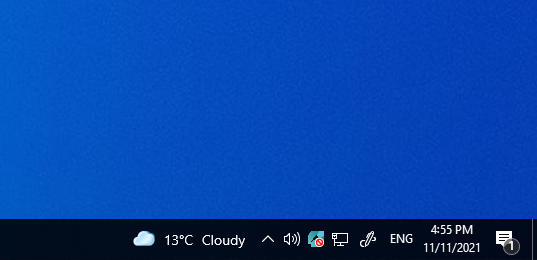Getting feedback via Info Surveys
In this scenario the IT team want to make improvements to the way they provide their IT services, and they want to get some feedback from their users to see how they are currently resolving issues. The end-user computing (EUC) manager uses Experience to create and send a one-off survey to the users asking about how they currently resolve issues with IT. The users will have a week to choose to respond.
Creating a new Info Survey
The Experience→User Engagement page is where you manage all the Sentiment, Info Surveys and Announcements that have been created in Experience. You can easily see for each engagement the Options that it has been configured with, what Management Groups it has been assigned to and whether it's Enabled or not. In the picture, you can see the state following on from the Getting feedback via Sentiment Surveys scenario.
Click the New Engagement button to begin.
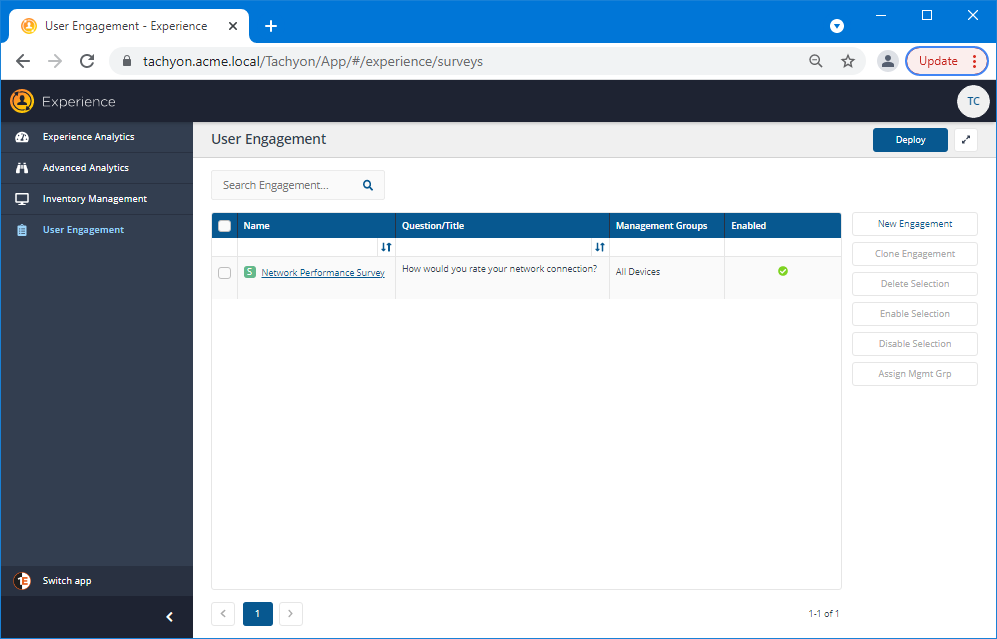
Info Surveys?
The first choice you face is what type of engagement you want to create.
Sentiment Surveys are more limited than Info Surveys in the range of possible responses you can select from, but this also means they can be consistently measured and reported on. However, in this scenario, the EUC manager doesn't want to create a survey that contributes towards the Sentiment score. Instead, they want to create a one-off survey to gather some user feedback on how end-users currently resolve their IT issues, they won't want to monitor the results as part of an ongoing assessment of user experience and so would choose an Info Survey.
The responses for Info Surveys can be modified to a larger extent than Sentiment Surveys, making them great for doing this type of arbitrary quick poll, but remember that they don't contribute to the Sentiment Score and therefore cannot be monitored over time.
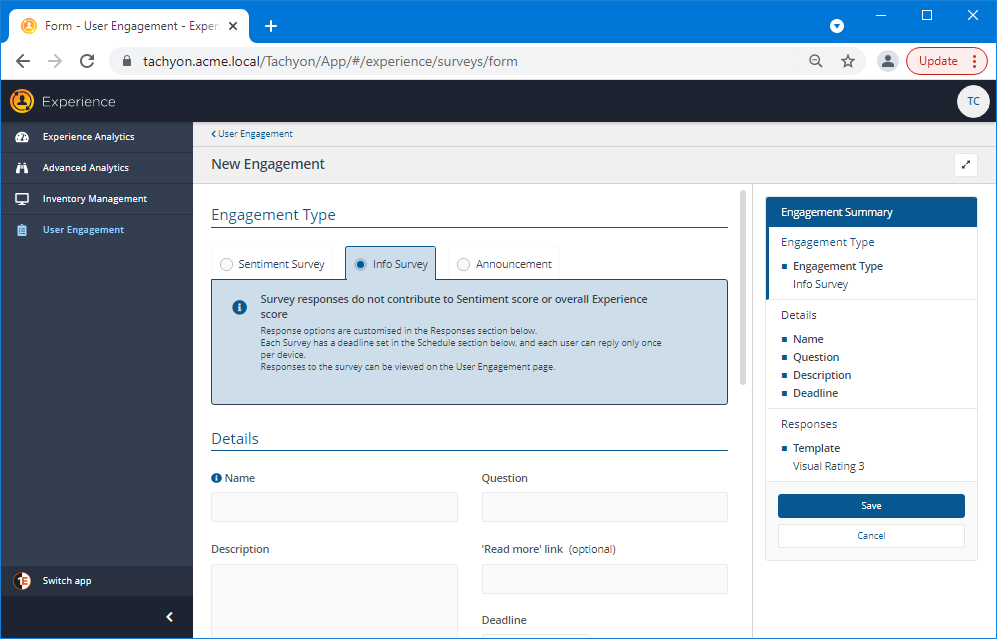
Names, Questions, Descriptions and Deadlines
Having selected the Info Survey type the next steps are to set a Name for the survey, the Question and Description that will frame the purpose of the survey and the range of Responses that will be allowed.
The Name for an Info Survey is not stored as a metric that Experience can then report on. The Name must be unique amongst all the survey names that have been defined for Experience, but does not have to avoid other Metric names. For example, unlike Sentiment Surveys, Network on its own could be used as the Name for an Info Survey, even though this is already a metric that Experience reports on. It is best to choose a good name for the survey that reflects the type of question being asked, in this scenario the EUC manager names the survey: Preferred IT Resolution.
Just as in Sentiment Surveys, the Question frames the survey's meaning and purpose, if the question you choose has not been thought through carefully you will likely confuse your end-users and skew the results. For Info Surveys, the responses you set for the survey can be customized, so a wider variety of questions can be asked. In our scenario, the EUC manager sets the question to: What is your preferred way of resolving IT issues?
Like Sentiment Surveys, the Description for Info Surveys is displayed to the end-user alongside the question and should provide additional context. Use it to capture their attention and provide some guidance as to how the question should be considered. Here, the EUC manager sets the Description to: We're looking at how we can improve the way we provide support. You can help by letting us know what your preferred method of resolving IT issues is. This sets the scene for why the question is being asked and gives a small indication on how it could benefit the end-user and engages them in the process of improving IT. This aspect of the survey is subtler than determining the question but can still be important in terms of encouraging the maximum number of responses possible.
Unlike Sentiment Surveys, Info Surveys are only sent out once and end-users can only make a response once. You can, however, set a Deadline for receiving responses, this gives end-users a time range to interact with the survey and send their feedback. Before the deadline occurs, users that haven't yet responded will be prompted repeatedly at appropriate times to make a response. In this scenario, the EUC manager sets the Deadline to 17/11/2021, giving their end-users 7 days to complete. After that time, the survey is closed and the prompts will no longer appear to users who haven't yet responded.
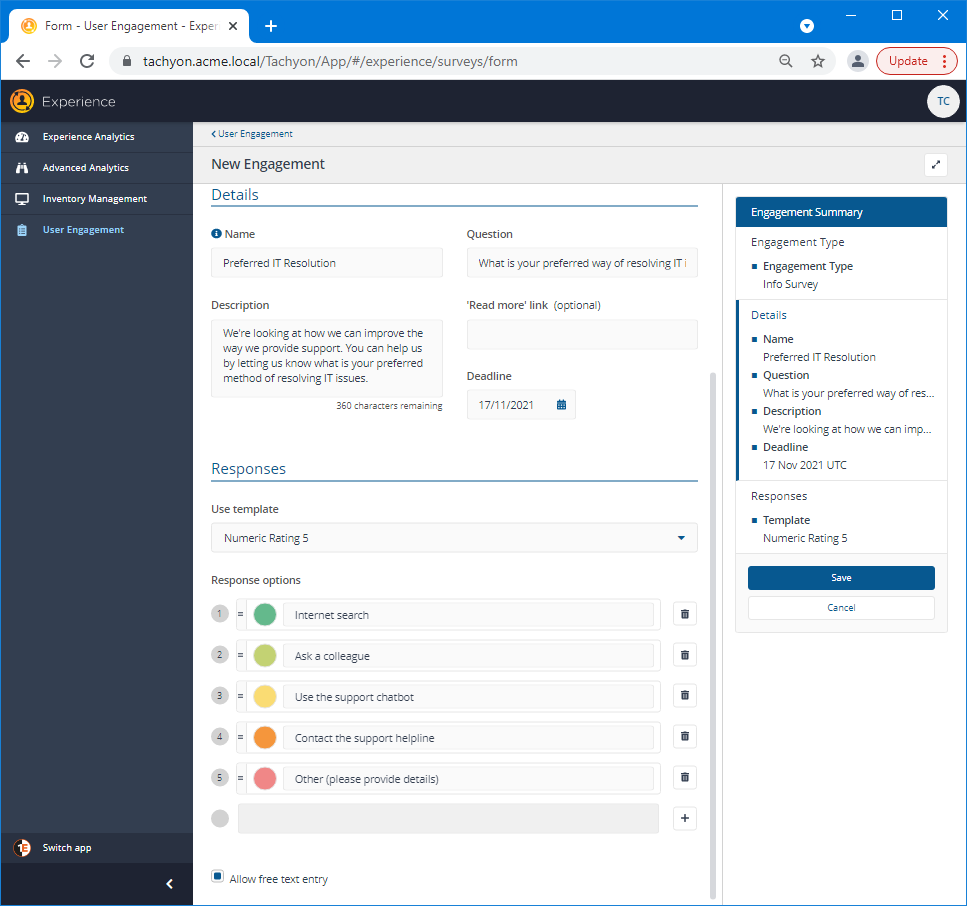
Defining the responses to the survey
The Responses must be closely linked with the Question text, and you will likely need to adjust both before you get a suitable fit that is obvious, simple and effective. Info Surveys let you choose a greater range, edit the responses text and select from a wider palette of colors and icons. But, because of that flexibility, they cannot be measured consistently and therefore cannot contribute towards the Sentiment score and have no bearing on the overall Experience score. Initially, the EUC manager selects Numeric Rating 5 for the response options. This gives them five options they can modify, choosing to add more responses (up to a maximum of 10) or remove some. The text of each response can also be edited. For this scenario, the EUC manager edits the text to allow the end-user to choose from the following options:
Internet search
Ask a colleague
Use the support chatbot
Contact the support helpline
Other (please provide details)
To support the last option the EUC manager also checks the Allow free text entry checkbox to give the end-users the opportunity to qualify the Other response by entering text that describes their other method of resolving IT issues.
Saving the new survey
When you're happy with the settings you've made in the survey editor you can click Save to commit the changes and continue to the next step.
Setting the Management Groups for the new survey
Sentiment Surveys default to the All Devices Management Group, so they always have a target. Info Surveys don't have a default Management Group, so one must be assigned before the survey can be enabled and then deployed. For this survey the EUC manager wants to poll all of their end-users, so they will assign the All Devices Management Group.
To do this:
They select the survey and then click the Assign Mgmt Grp button.
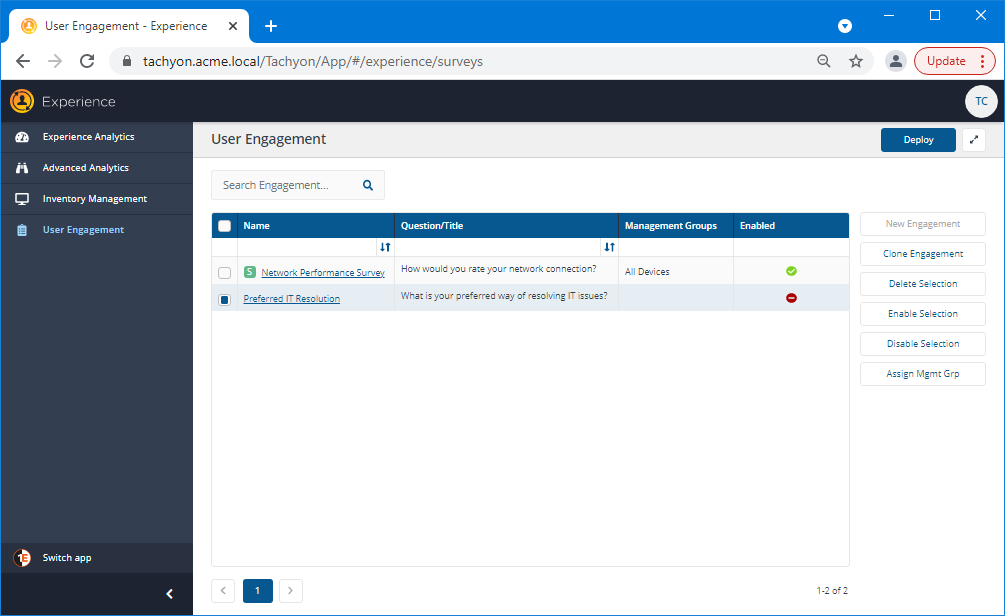
In the Assign Management Groups popup subsequently displayed, they type All into the search field and then select All Devices from the list of matching Management Groups. This gets added to the New Management Groups field.
They click Save to assign the Management Group.

Enabling the new survey
New surveys are not enabled by default. Before they can be deployed, they must be explicitly enabled, providing an additional gateway that prevents the survey being sent out too soon before it's ready.
To enable the new Info Survey the EUC manager:
Selects the checkbox at the left-hand end of each survey's entry in the Engagements table and then click the Enable Selection button.
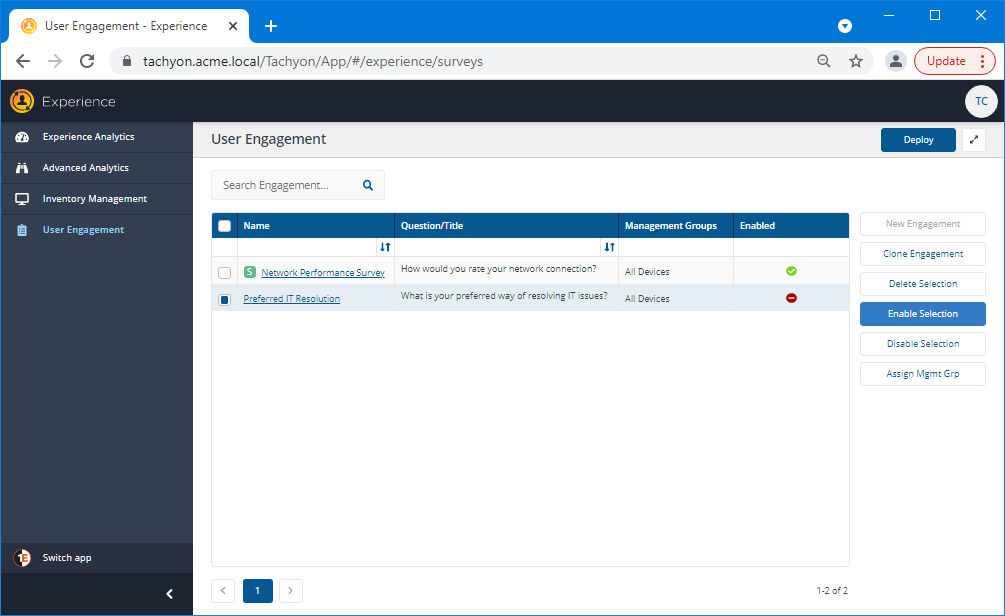
Doing this displays an Enable Selection confirmation popup that you must acknowledge before the selected engagements are actually enabled. Click Yes to confirm the operation and No to cancel it.
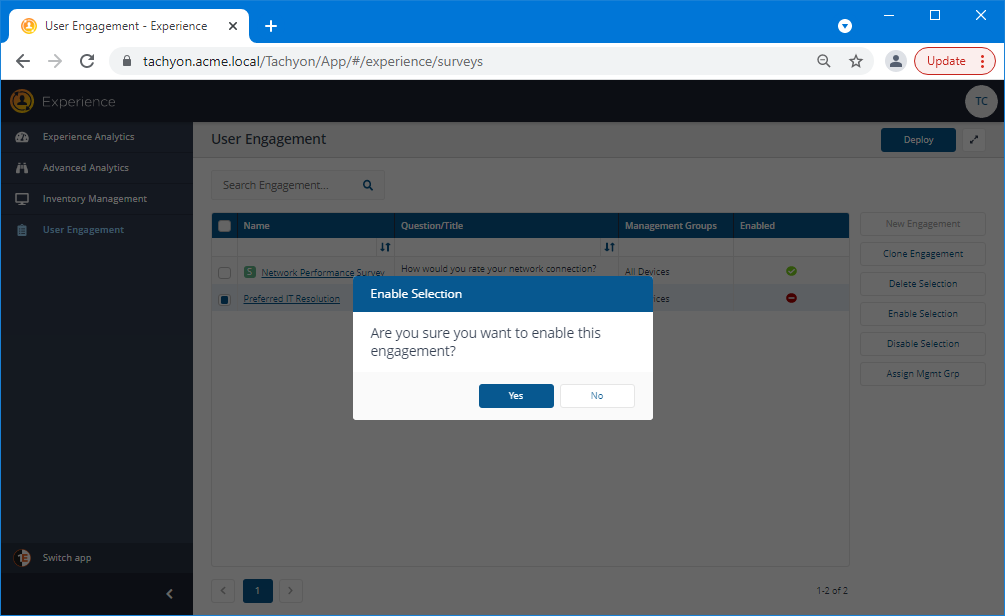
Deploying the new survey
So the new Info Survey has the All Devices Management Group assigned and has been enabled, it can now be sent to the end-users' devices by clicking the Deploy button, which will send the survey to all the devices currently and subsequently connected to Tachyon.
Note
The Deploy button will send out any changes to the states of the surveys - meaning you can also use it to set previously deployed surveys to not Enabled, thereby preventing further responses without completely deleting the survey, or you can delete surveys when they are no longer needed. You should be aware that the Deploy button will also send any other User Engagement administrator's changes.
It is good practice to test the survey on a few machines first before deploying to All Devices. This lets you see how the survey will appear to your end-users and gives you the opportunity to debug the text and selections before deploying to a wider audience. Doing this involves assigning a different Management Group to the survey that targets the selected devices.
In our example, which only involves a few devices anyway, to keep things simple we can get away with sending the Info Survey out without testing, so the EUC manager clicks the Deploy button.
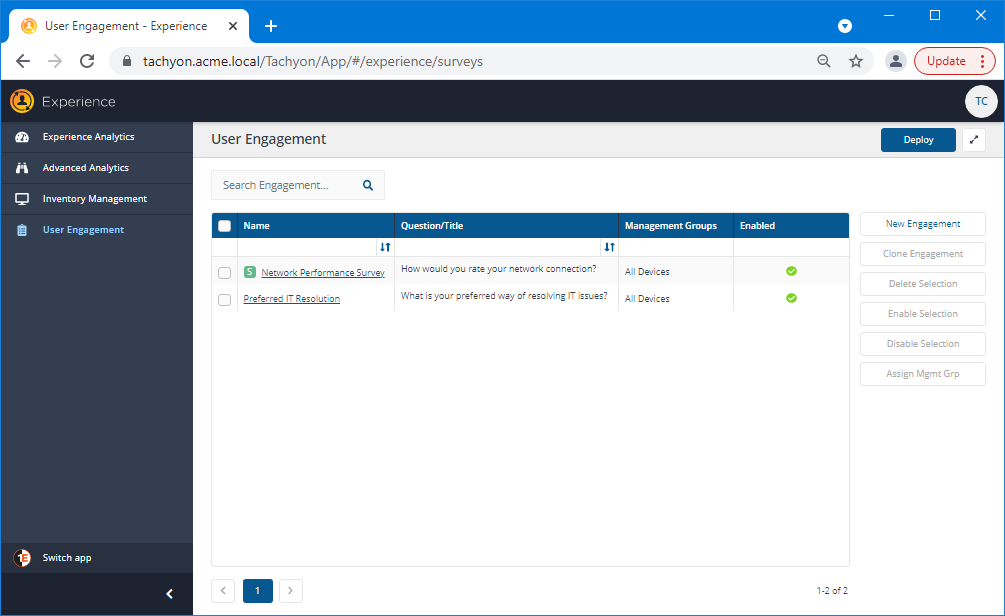
An Engagements Deployment popup appears that shows the changes that will be deployed when the Yes button is clicked. The EUC manager reads the list carefully, sees that the only changes are the ones related to creating, assigning Management Groups and enabling the Preferred IT Resolution survey and clicks Yes. Subsequently, a notification will appear showing that the policy changes are being applied to the Tachyon Agents.

What the end-user sees
When the 1E Client is installed on a network device, by default it also adds an icon to the notification area that displays the Real-Time Control Center (RTCC). Initially the icon may be hidden, but may be dragged onto the taskbar to make it always visible. When an end-user clicks on the notification icon they will see the Surveys and Announcements that have been deployed to the device.
Note
Although Info Surveys are displayed in the list of available surveys, you cannot display them by clicking. Instead, for Info Surveys, the end-user must wait until they appear.
When does the survey appear?
To minimize the disruption to the end-user of having a survey popup when they're busy using the computer for other things, the 1E Client has a few heuristics that govern when the notifications appear. These measure and compare things like: whether the user is currently interacting with the device, how long it has been since they stopped interacting with the device, how long the notifications should wait before re-displaying if the user didn't respond to the last time it was displayed. These various options interact to essentially display the notification in the sweet spot between the user not actively doing something and the user having left their device.
Info Surveys also provide an option to Dismiss, which means that they don't want to answer the survey at all, or click Later, which means that they don't want to be bothered just at this moment but may respond when the notification is next displayed.
Note
Your end-users can also set the Do not disturb option, which prevents notifications from appearing for a configurable time period. Please refer to Do not disturb... for more details.
Responding to the survey
In our scenario, the deployed Info Survey pops up on an end-user's device. They can see both the question and the description text that was defined as part of the survey, along with the range of five customized options for responding and a free text edit box labelled Anything more you'd like to tell us?. Although the intention of the EUC manager is for this free text to be associated with the Other (please provide details) option, there's nothing to stop the end-user from adding extra information to help clarify any of their choices. There's also nothing to stop the end-user from selecting the Other option and not filling out the text box. This is why it is critical for the EUC manager to label the option correctly and at least provide a hint that more details should be added if that option is selected.
Note
The following 1E Client settings are used to configure the behavior of the Real-Time Control Center. If you click on a link, it will take you to the 1E Client documentation space.
Module.Interaction.Enabled | Module.Interaction.ActiveSessionThresholdSeconds | Module.Interaction.CompanyName | Module.Interaction.DoNotDisturb | Module.Interaction.IdleSessionThresholdMinutes | Module.Interaction.ITSM.ServiceNow.CreateIncidents | Module.Interaction.ITSM.ServiceNow.Enabled | Module.Interaction.ITSM.ServiceNow.GoBackDays | Module.Interaction.ITSM.ServiceNow.Url | Module.Interaction.LogSessionNotificationReadiness | Module.Interaction.MinimumMinutesAfterLogonBeforePrompt | Module.Interaction.MinimumMinutesAfterSessionActivationBeforePrompt | Module.Interaction.MinimumMinutesBetweenPrompts | Module.Interaction.NotificationIcon | Module.Interaction.PeriodsBeforeUiLaunch | Module.Interaction.PeriodsBeforeUiLaunchTimeout | Module.Interaction.Port | Module.Interaction.ResponseAuditsBeforeTidy | Module.Interaction.ResponseRetentionRows | Module.Interaction.SampleExclusionList | Module.Interaction.SampleUserInteraction | Module.Interaction.SnoozeTimeMinutes | Module.Interaction.Theme
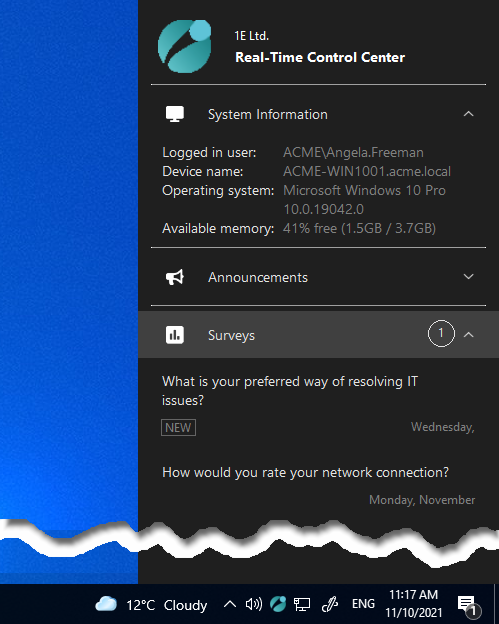
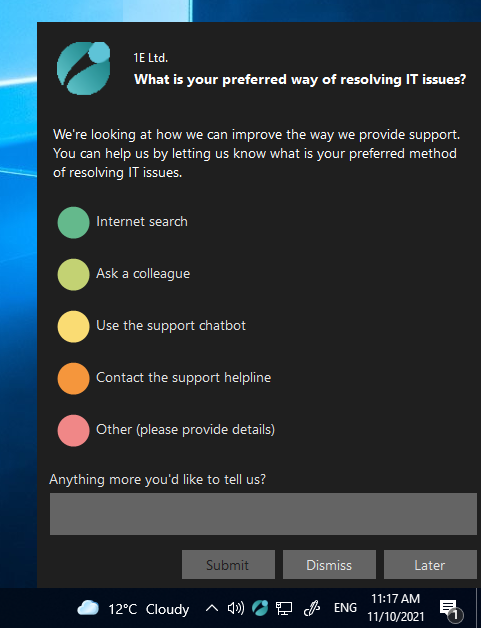
Submitting a response to the survey
The end-user will need to click on the response they want to make before the Submit button becomes enabled.
Our end-user is fairly tech-savvy and likes to sort their own problems as far as possible, so they click on the Internet search response and then on Submit.
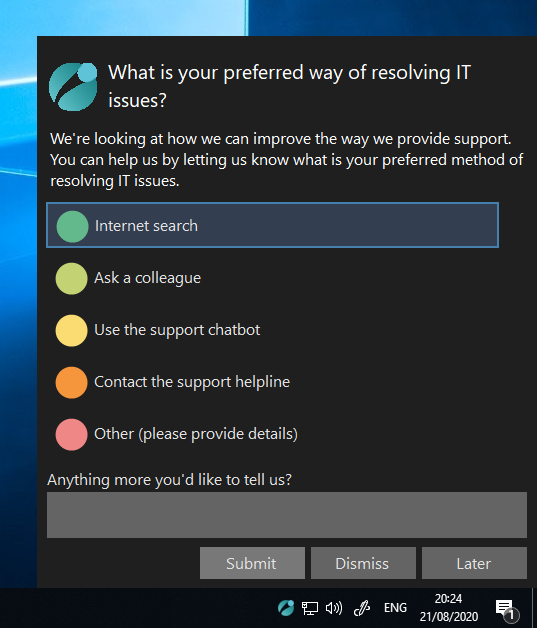
Viewing survey responses
The Preferred IT Resolution survey has been deployed and end-users have begun to respond, the EUC manager wants to monitor those responses. For an Info Survey the only place the responses can be viewed is from its details page, you get to this by clicking on the link for the survey in the Name column of the Engagements table on the User Engagement page.
In the picture, the EUC manager has clicked on the Preferred IT Resolution link to display its details page. Here, they can see that a user has submitted a response.
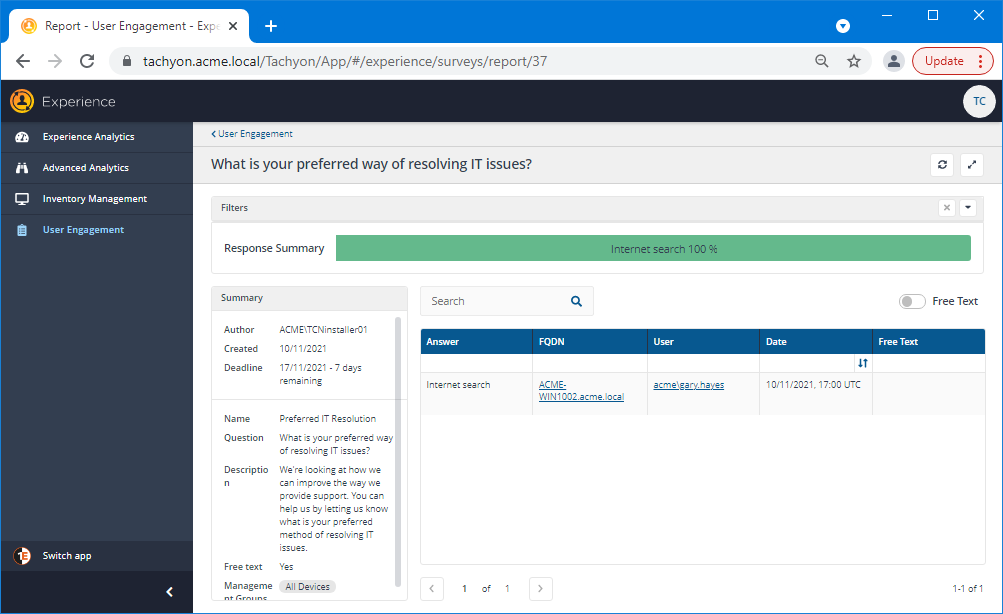
After a number of responses have been made a clearer picture of the current user behavior appears. The majority of users Contact the support helpline. The next most popular option is to use Internet search and try to resolve their own issues. Ask a colleague is the next used option along with Other, the text that went with that response indicates that the user is a member of an IT support forum. A surprising aspect of the survey is that no one prefers the support chatbot, Perhaps that is because it is difficult to find, or that the users have had a poor experience with it. Perhaps the EUC manager would want to follow up with another survey specifically aimed at getting feedback on the support chatbot. Clearly, the survey has performed its task and provided the EUC manager with information that will be useful to the IT department in terms of improving their IT service for end-users.
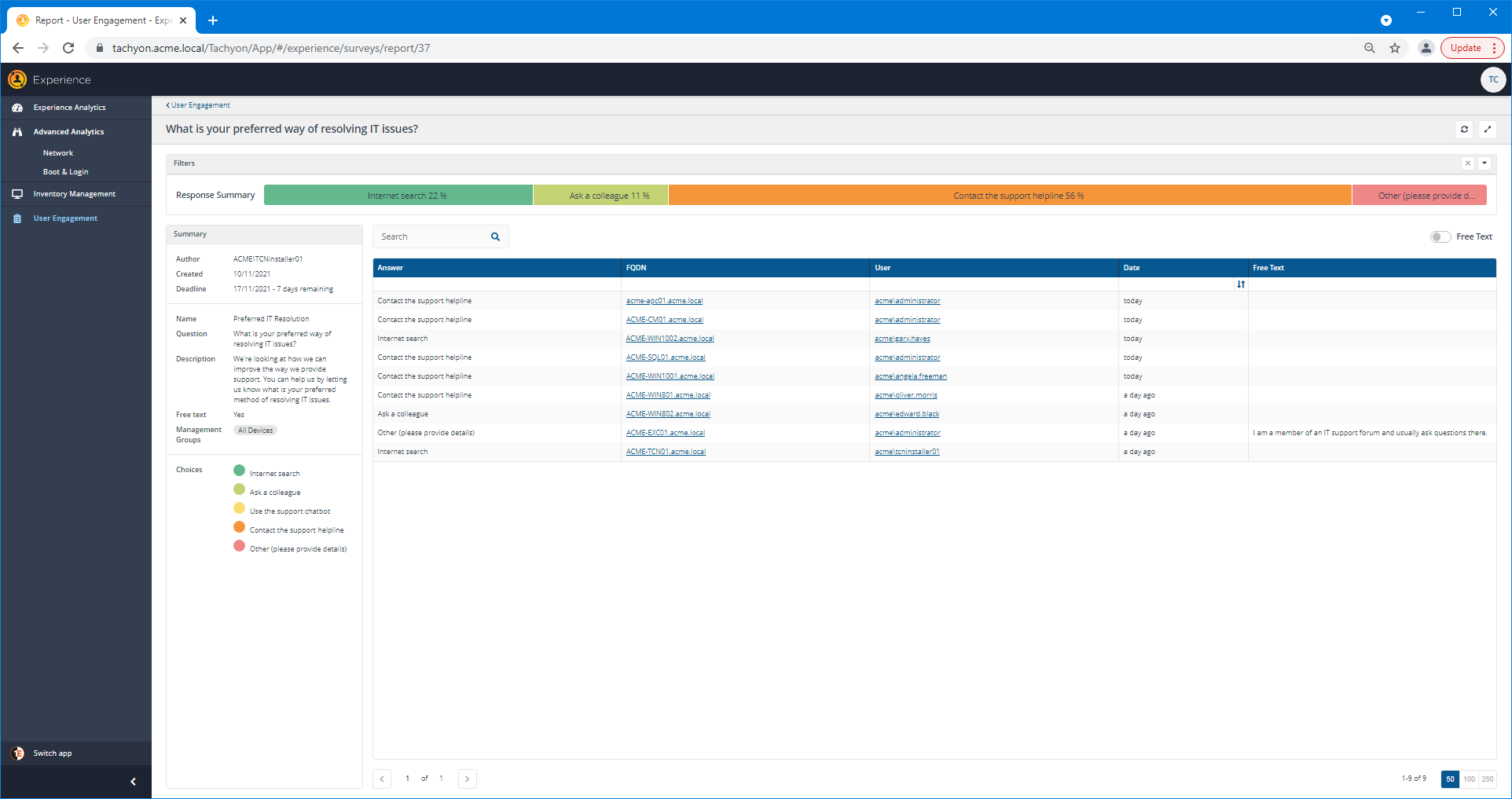
Do not disturb...
Sometimes your end-users want to be left undisturbed by survey notifications. They may be concentrating on a tricky piece of work or using their device to present to an audience and the last thing they want is a survey notification to popup unexpectedly. In these cases, the end-user can interact with the 1E Client notification icon to temporarily suspend notifications from appearing.
To do this, the end-user would:
Right-click on the 1E Client notification icon to display the Do not disturb... option.
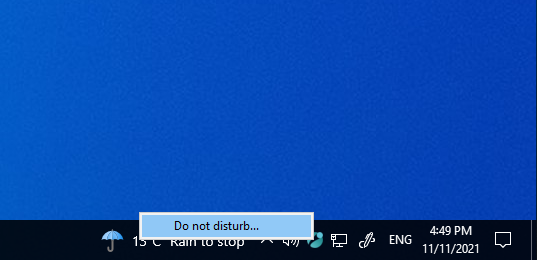
In the Do not disturb popup they would select the behavior they want to set.
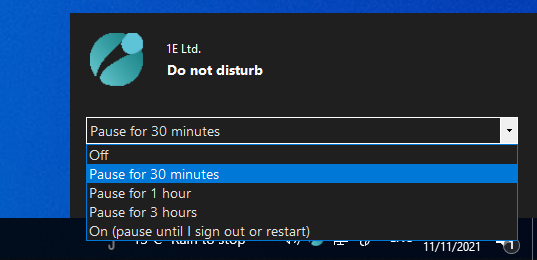
The options are:
Option
Description
Off
Sets the Do not disturb feature to off. Notifications will appear as normal.
Pause for 30 minutes, 1 hour, 3 hours
Set the Do not disturb feature to on for the selected time period. Notifications will not appear during the selected period, 30 minutes, 1 hour or 3 hours. After that time notifications will appear as normal.
On (pause until I sign out or restart)
Set the Do not disturb feature to on until the end-user signs out or restarts their device.
After selecting one of the options that turns the Do not disturb feature to on, the notification icon will change to indicate that notifications will not appear.
